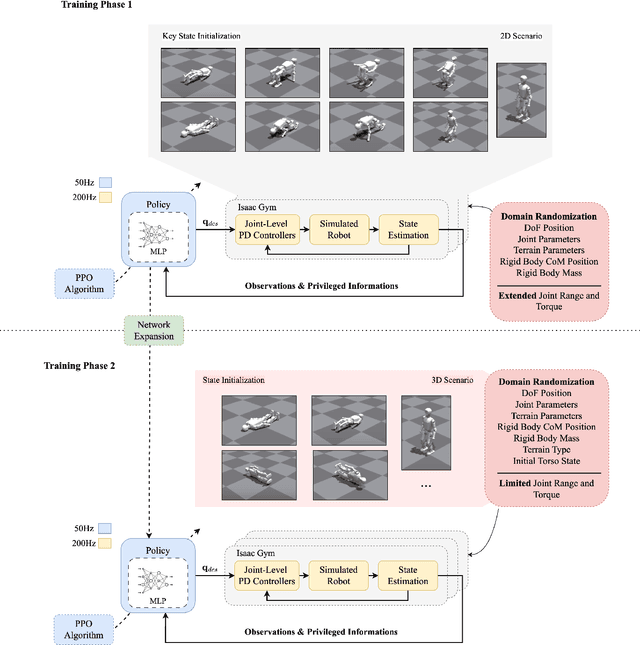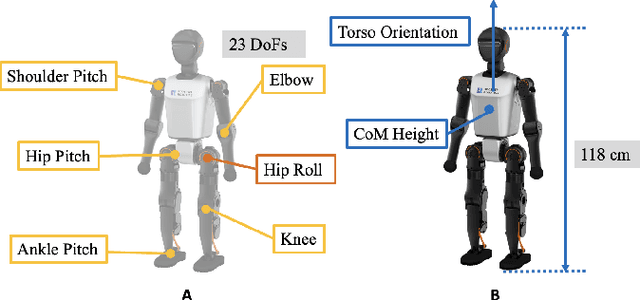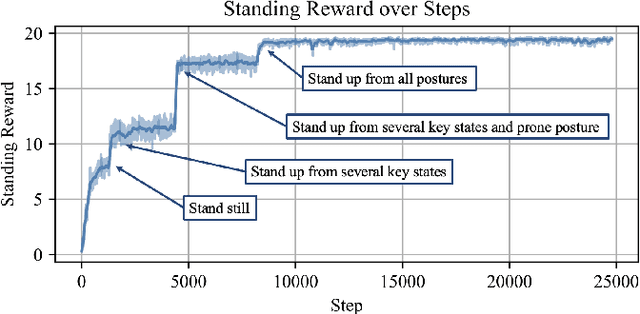Yushi Wang
Booster Gym: An End-to-End Reinforcement Learning Framework for Humanoid Robot Locomotion
Jun 18, 2025Abstract:Recent advancements in reinforcement learning (RL) have led to significant progress in humanoid robot locomotion, simplifying the design and training of motion policies in simulation. However, the numerous implementation details make transferring these policies to real-world robots a challenging task. To address this, we have developed a comprehensive code framework that covers the entire process from training to deployment, incorporating common RL training methods, domain randomization, reward function design, and solutions for handling parallel structures. This library is made available as a community resource, with detailed descriptions of its design and experimental results. We validate the framework on the Booster T1 robot, demonstrating that the trained policies seamlessly transfer to the physical platform, enabling capabilities such as omnidirectional walking, disturbance resistance, and terrain adaptability. We hope this work provides a convenient tool for the robotics community, accelerating the development of humanoid robots. The code can be found in https://github.com/BoosterRobotics/booster_gym.
TS-URGENet: A Three-stage Universal Robust and Generalizable Speech Enhancement Network
May 24, 2025Abstract:Universal speech enhancement aims to handle input speech with different distortions and input formats. To tackle this challenge, we present TS-URGENet, a Three-Stage Universal, Robust, and Generalizable speech Enhancement Network. To address various distortions, the proposed system employs a novel three-stage architecture consisting of a filling stage, a separation stage, and a restoration stage. The filling stage mitigates packet loss by preliminarily filling lost regions under noise interference, ensuring signal continuity. The separation stage suppresses noise, reverberation, and clipping distortion to improve speech clarity. Finally, the restoration stage compensates for bandwidth limitation, codec artifacts, and residual packet loss distortion, refining the overall speech quality. Our proposed TS-URGENet achieved outstanding performance in the Interspeech 2025 URGENT Challenge, ranking 2nd in Track 1.
Close-Fitting Dressing Assistance Based on State Estimation of Feet and Garments with Semantic-based Visual Attention
May 06, 2025Abstract:As the population continues to age, a shortage of caregivers is expected in the future. Dressing assistance, in particular, is crucial for opportunities for social participation. Especially dressing close-fitting garments, such as socks, remains challenging due to the need for fine force adjustments to handle the friction or snagging against the skin, while considering the shape and position of the garment. This study introduces a method uses multi-modal information including not only robot's camera images, joint angles, joint torques, but also tactile forces for proper force interaction that can adapt to individual differences in humans. Furthermore, by introducing semantic information based on object concepts, rather than relying solely on RGB data, it can be generalized to unseen feet and background. In addition, incorporating depth data helps infer relative spatial relationship between the sock and the foot. To validate its capability for semantic object conceptualization and to ensure safety, training data were collected using a mannequin, and subsequent experiments were conducted with human subjects. In experiments, the robot successfully adapted to previously unseen human feet and was able to put socks on 10 participants, achieving a higher success rate than Action Chunking with Transformer and Diffusion Policy. These results demonstrate that the proposed model can estimate the state of both the garment and the foot, enabling precise dressing assistance for close-fitting garments.
HiFAR: Multi-Stage Curriculum Learning for High-Dynamics Humanoid Fall Recovery
Feb 28, 2025



Abstract:Humanoid robots encounter considerable difficulties in autonomously recovering from falls, especially within dynamic and unstructured environments. Conventional control methodologies are often inadequate in addressing the complexities associated with high-dimensional dynamics and the contact-rich nature of fall recovery. Meanwhile, reinforcement learning techniques are hindered by issues related to sparse rewards, intricate collision scenarios, and discrepancies between simulation and real-world applications. In this study, we introduce a multi-stage curriculum learning framework, termed HiFAR. This framework employs a staged learning approach that progressively incorporates increasingly complex and high-dimensional recovery tasks, thereby facilitating the robot's acquisition of efficient and stable fall recovery strategies. Furthermore, it enables the robot to adapt its policy to effectively manage real-world fall incidents. We assess the efficacy of the proposed method using a real humanoid robot, showcasing its capability to autonomously recover from a diverse range of falls with high success rates, rapid recovery times, robustness, and generalization.
Dual-arm Motion Generation for Repositioning Care based on Deep Predictive Learning with Somatosensory Attention Mechanism
Jul 18, 2024Abstract:A versatile robot working in a domestic environment based on a deep neural network (DNN) is currently attracting attention. One of the roles expected for domestic robots is caregiving for a human. In particular, we focus on repositioning care because repositioning plays a fundamental role in supporting the health and quality of life of individuals with limited mobility. However, generating motions of the repositioning care, avoiding applying force to non-target parts and applying appropriate force to target parts, remains challenging. In this study, we proposed a DNN-based architecture using visual and somatosensory attention mechanisms that can generate dual-arm repositioning motions which involve different sequential policies of interaction force; contact-less reaching and contact-based assisting motions. We used the humanoid robot Dry-AIREC, which features the capability to adjust joint impedance dynamically. In the experiment, the repositioning assistance from the supine position to the sitting position was conducted by Dry-AIREC. The trained model, utilizing the proposed architecture, successfully guided the robot's hand to the back of the mannequin without excessive contact force on the mannequin and provided adequate support and appropriate contact for postural adjustment.
Analyzing Deep Learning Based Brain Tumor Segmentation with Missing MRI Modalities
Aug 06, 2022Abstract:This technical report presents a comparative analysis of existing deep learning (DL) based approaches for brain tumor segmentation with missing MRI modalities. Approaches evaluated include the Adversarial Co-training Network (ACN) and a combination of mmGAN and DeepMedic. A more stable and easy-to-use version of mmGAN is also open-sourced at a GitHub repository. Using the BraTS2018 dataset, this work demonstrates that the state-of-the-art ACN performs better especially when T1c is missing. While a simple combination of mmGAN and DeepMedic also shows strong potentials when only one MRI modality is missing. Additionally, this work initiated discussions with future research directions for brain tumor segmentation with missing MRI modalities.
On The State of Data In Computer Vision: Human Annotations Remain Indispensable for Developing Deep Learning Models
Jul 31, 2021Abstract:High-quality labeled datasets play a crucial role in fueling the development of machine learning (ML), and in particular the development of deep learning (DL). However, since the emergence of the ImageNet dataset and the AlexNet model in 2012, the size of new open-source labeled vision datasets has remained roughly constant. Consequently, only a minority of publications in the computer vision community tackle supervised learning on datasets that are orders of magnitude larger than Imagenet. In this paper, we survey computer vision research domains that study the effects of such large datasets on model performance across different vision tasks. We summarize the community's current understanding of those effects, and highlight some open questions related to training with massive datasets. In particular, we tackle: (a) The largest datasets currently used in computer vision research and the interesting takeaways from training on such datasets; (b) The effectiveness of pre-training on large datasets; (c) Recent advancements and hurdles facing synthetic datasets; (d) An overview of double descent and sample non-monotonicity phenomena; and finally, (e) A brief discussion of lifelong/continual learning and how it fares compared to learning from huge labeled datasets in an offline setting. Overall, our findings are that research on optimization for deep learning focuses on perfecting the training routine and thus making DL models less data hungry, while research on synthetic datasets aims to offset the cost of data labeling. However, for the time being, acquiring non-synthetic labeled data remains indispensable to boost performance.
 Add to Chrome
Add to Chrome Add to Firefox
Add to Firefox Add to Edge
Add to Edge